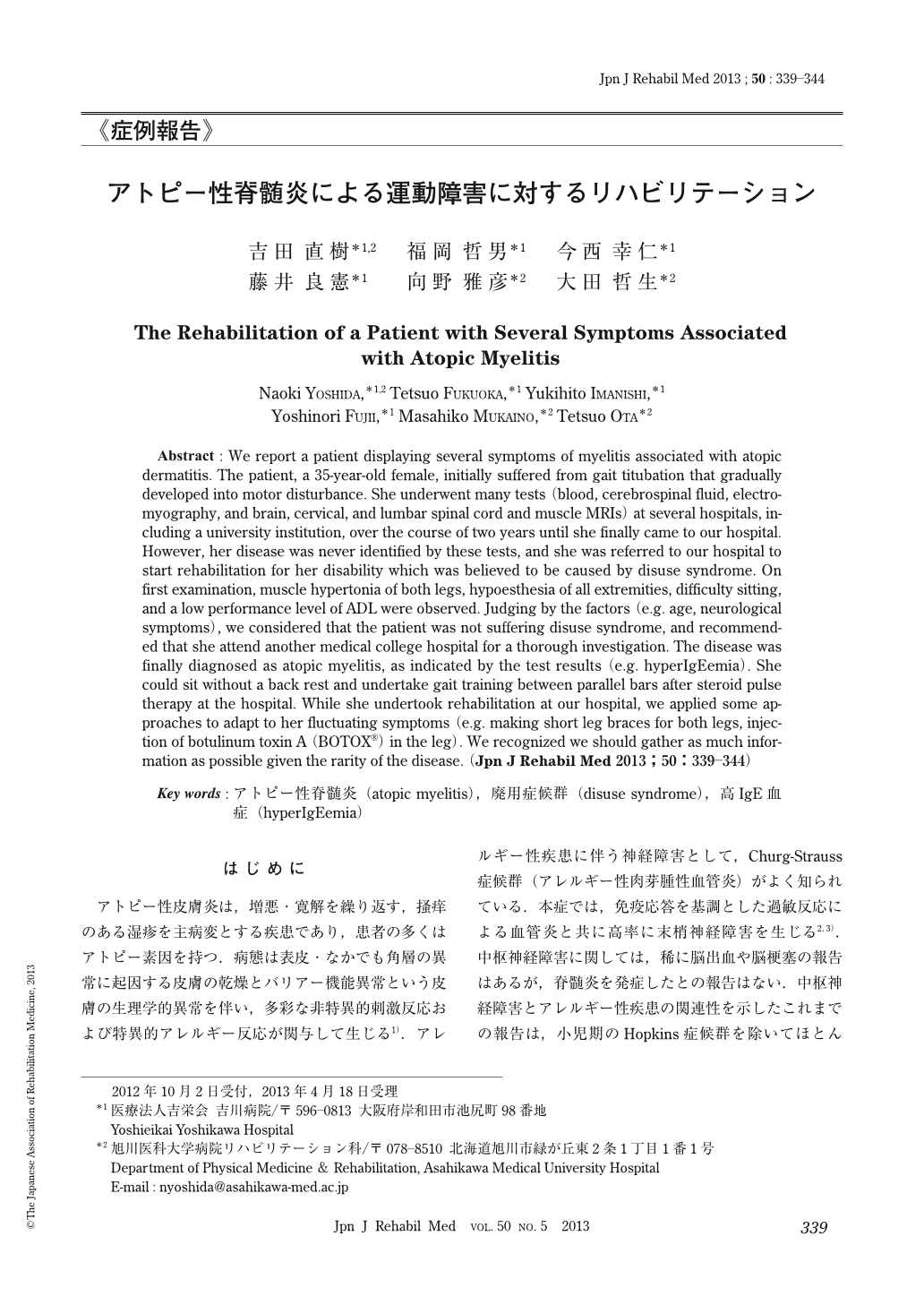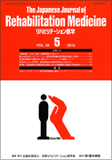Japanese
English
- 販売していません
- Abstract 文献概要
- 1ページ目 Look Inside
- 参考文献 Reference
はじめに
アトピー性皮膚炎は,増悪・寛解を繰り返す,掻痒のある湿疹を主病変とする疾患であり,患者の多くはアトピー素因を持つ.病態は表皮・なかでも角層の異常に起因する皮膚の乾燥とバリアー機能異常という皮膚の生理学的異常を伴い,多彩な非特異的刺激反応および特異的アレルギー反応が関与して生じる1).アレルギー性疾患に伴う神経障害として,Churg-Strauss症候群(アレルギー性肉芽腫性血管炎)がよく知られている.本症では,免疫応答を基調とした過敏反応による血管炎と共に高率に末梢神経障害を生じる2,3).中枢神経障害に関しては,稀に脳出血や脳梗塞の報告はあるが,脊髄炎を発症したとの報告はない.中枢神経障害とアレルギー性疾患の関連性を示したこれまでの報告は,小児期のHopkins症候群を除いてほとんど認められない.この症候群は喘息発作後2週間以内に発症する急性脊髄炎により弛緩性麻痺を呈する疾患である3~5).1997年にKiraらは成人のアトピー性皮膚炎患者で頸髄炎がみられることを報告した6).これらの症例では頸髄に病巣を有し,一旦発症すると慢性動揺性の臨床経過をたどり脊髄MRI(magnetic resonance imaging)上,異常を認めるなど特異な病像を示している.また種々の中枢神経疾患患者で血清全IgE(immunoglobulin E)およびアレルゲン特異的IgEを測定し,ウイルス性など原因の明らかなものを除いた脊髄炎の患者(アトピー性皮膚炎合併群を含む)では,健常対照より有意に高IgE血症の頻度および血清ダニ抗原特異的IgE陽性率が高いことを明らかにした7).そこでKiraらはその機序に関して,アトピーを基盤として脊髄に炎症を生じる病態と考え,アトピー性脊髄炎(atopic myelitis:AM)との病名を提唱している6,8,9).今回,この稀な疾患を経験したので,リハビリテーション(以下,リハ)の経過も含めて報告する.
Abstract : We report a patient displaying several symptoms of myelitis associated with atopic dermatitis. The patient, a 35-year-old female, initially suffered from gait titubation that gradually developed into motor disturbance. She underwent many tests (blood, cerebrospinal fluid, electromyography, and brain, cervical, and lumbar spinal cord and muscle MRIs) at several hospitals, including a university institution, over the course of two years until she finally came to our hospital. However, her disease was never identified by these tests, and she was referred to our hospital to start rehabilitation for her disability which was believed to be caused by disuse syndrome. On first examination, muscle hypertonia of both legs, hypoesthesia of all extremities, difficulty sitting, and a low performance level of ADL were observed. Judging by the factors (e.g. age, neurological symptoms), we considered that the patient was not suffering disuse syndrome, and recommended that she attend another medical college hospital for a thorough investigation. The disease was finally diagnosed as atopic myelitis, as indicated by the test results (e.g. hyperIgEemia). She could sit without a back rest and undertake gait training between parallel bars after steroid pulse therapy at the hospital. While she undertook rehabilitation at our hospital, we applied some approaches to adapt to her fluctuating symptoms (e.g. making short leg braces for both legs, injection of botulinum toxin A (BOTOX®) in the leg). We recognized we should gather as much information as possible given the rarity of the disease.

Copyright © 2013, The Japanese Association of Rehabilitation Medicine. All rights reserved.


